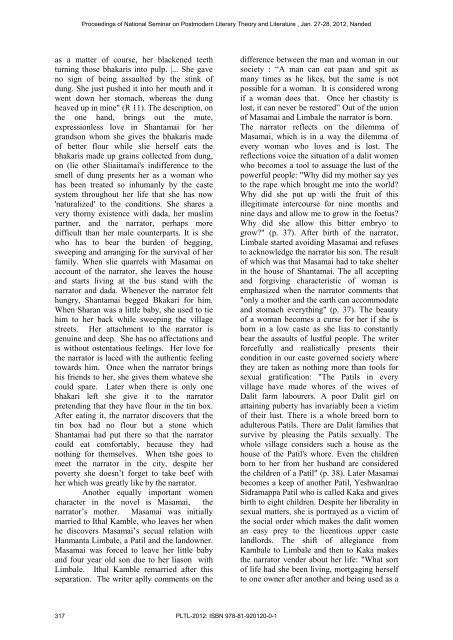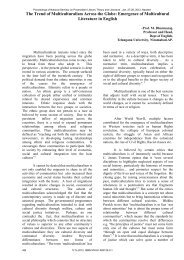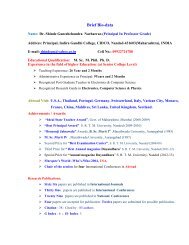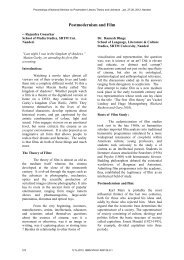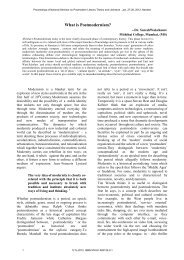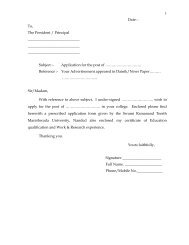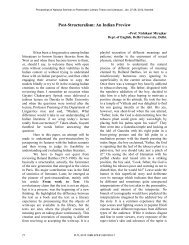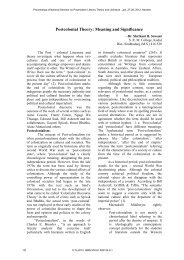Postcolonial Feminist Theory: An Overview - Igcollege.org
Postcolonial Feminist Theory: An Overview - Igcollege.org
Postcolonial Feminist Theory: An Overview - Igcollege.org
You also want an ePaper? Increase the reach of your titles
YUMPU automatically turns print PDFs into web optimized ePapers that Google loves.
Proceedings of National Seminar on Postmodern Literary <strong>Theory</strong> and Literature , Jan. 27-28, 2012, Nandedas a matter of course, her blackened teethturning those bhakaris into pulp. |... She gaveno sign of being assaulted by the stink ofdung. She just pushed it into her mouth and itwent down her stomach, whereas the dungheaved up in mine" (R 11). The description, onthe one hand, brings out the mute,expressionless love in Shantamai for hergrandson whom she gives the bhakaris madeof better flour while slie herself eats thebhakaris made up grains collected from dung,on (lie other Sliaiitamai's indifference to thesmell of dung presents her as a woman whohas been treated so inhumanly by the castesystem throughout her life that she has now'naturalized' to the conditions. She shares avery thorny existence witli dada, her muslimpartner, and the narrator, perhaps moredifficult than her male counterparts. It is shewho has to bear the burden of begging,sweeping and arranging for the survival of herfamily. When slie quarrels with Masamai onaccount of the narrator, she leaves the houseand starts living at the bus stand with thenarrator and dada. Whenever the narrator felthungry, Shantamai begged Bkakari for him.When Sharan was a little baby, she used to tiehim to her back while sweeping the villagestreets. Her attachment to the narrator isgenuine and deep. She has no affectations andis without ostentatious feelings. Her love forthe narrator is laced with the authentic feelingtowards him. Once when the narrator bringshis friends to her, she gives them whateve shecould spare. Later when there is only onebhakari left she give it to the narratorpretending that they have flour in the tin box.After eating it, the narrator discovers that thetin box had no flour but a stone whichShantamai had put there so that the narratorcould eat comfortably, because they hadnothing for themselves. When tshe goes tomeet the narrator in the city, despite herpoverty she doesn’t f<strong>org</strong>et to take beef withher which was greatly like by the narrator.<strong>An</strong>other equally important womencharacter in the novel is Masamai, thenarrator’s mother. Masamai was initiallymarried to Ithal Kamble, who leaves her whenhe discovers Masamai’s secual relation withHanmanta Limbale, a Patil and the landowner.Masamai was forced to leave her little babyand four year old son due to her liason withLimbale. Ithal Kamble remarried after thisseparation. The writer aplly comments on thedifference between the man and woman in oursociety : “A man can eat paan and spit asmany times as he likes, but the same is notpossible for a woman. It is considered wrongif a woman does that. Once her chastity islost, it can never be restored” Out of the unionof Masamai and Limbale the narrator is born.The narrator reflects on the dilemma ofMasamai, which is in a way the dilemma ofevery woman who loves and is lost. Thereflections voice the situation of a dalit womenwho becomes a tool to assuage the lust of thepowerful people: "Why did my mother say yesto the rape which brought me into the world?Why did she put up witli the fruit of thisillegitimate intercourse for nine months andnine days and allow me to grow in the foetus?Why did she allow this bitter embryo togrow?" (p. 37). After birth of the narrator,Limbale started avoiding Masamai and refusesto acknowledge the narrator his son. The resultof which was that Masamai had to take shelterin the house of Shantamai. The all acceptingand f<strong>org</strong>iving characteristic of woman isemphasized when the narrator comments that"only a mother and the earth can accommodateand stomach everything" (p. 37). The beautyof a woman becomes a curse for her if she isborn in a low caste as she lias to constantlybear the assaults of lustful people. The writerforcefully and realistically presents theircondition in our caste governed society wherethey are taken as nothing more than tools forsexual gratification: "The Patils in everyvillage have made whores of the wives ofDalit farm labourers. A poor Dalit girl onattaining puberty has invariably been a victimof their lust. There is a whole breed born toadulterous Patils. There are Dalit families thatsurvive by pleasing the Patils sexually. Thewhole village considers such a house as thehouse of the Patil's whore. Even the childrenborn to her from her husband are consideredthe children of a Patil" (p. 38). Later Masamaibecomes a keep of another Patil, YeshwanlraoSidramappa Patil who is called Kaka and givesbirth to eight children. Despite her liberality insexual matters, she is portrayed as a victim ofthe social order which makes the dalit womenan easy prey to the licentious upper castelandlords. The shift of allegiance fromKambale to Limbale and then to Kaka makesthe narrator vender about her life: "What sortof life had she been living, mortgaging herselfto one owner after another and being used as a317 PLTL-2012: ISBN 978-81-920120-0-1


